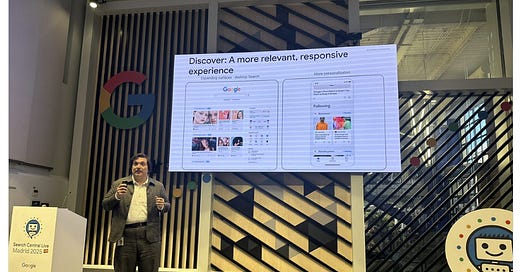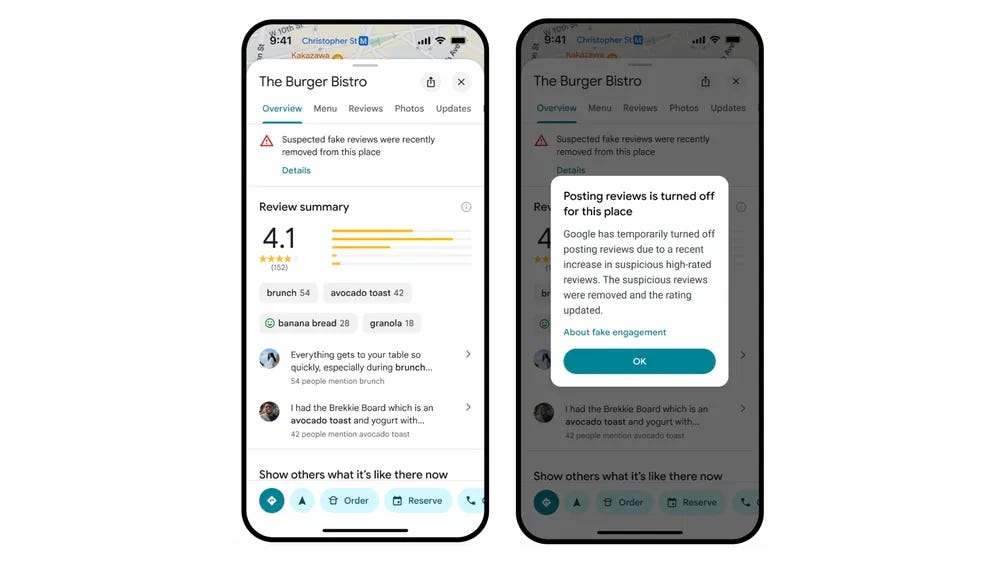Google Discover Coming to Desktop, Quality Raters Guidelines Update, How UX Affects SEO
SEO TL;DR #67 14/04/2025
I’ve just decompressed after a fantastic few days at brightonSEO, where I gave my first ever talk on Ecommerce SEO for Shopify. I’m finishing some tweaks to the deck and will email it over to everyone who asked for a copy (brightonSEO will be publically releasing all of the speaker decks in about 2 weeks).
I’ll also be doing a roundup of the talks I went to, so keep your eyes peeled for that over the next day or so.
Now, onto the search news.
SEO X AI
Image Uploads & More Links To Google In AI Search
AI Mode now supports image uploads via Lens, allowing users to ask questions about what they see in a photo and receive nuanced, AI-generated responses.
AI Overviews now link back to Google search results, not just third-party sites. Google says this helps users explore topics more easily, though the change has raised eyebrows, especially in this example from Lily Ray below, which links back to Google over 30 times!
💡 Takeaway: Google continues to build AI features that reduce friction, which will inevitably lead to more zero-click searches (~60% of searches don’t result in a click).
The unfortunate reality is that that if you want to continue receiving organic traffic from Google, you need to consider the impact of AI Overviews on your CTR and traffic and seek to be included in them.
🔗 Tips for ranking in AI Overviews - SEO TL;DR #62
🔗 How to be visible both in Search and LLMs - Gianluca Fiorelli, I Heart SEO
🔗 3 ways to optimise for AI search bots - Tim Resnik, Search Engine Land
Content SEO
Google Discover Is Coming to Desktop Search
After years of on-and-off testing, Google has confirmed that Discover will soon be coming to desktop. Announced at Search Central Live in Madrid, the feature will appear on the Google.com homepage, expanding what Google calls the “surfaces” where Discover is shown.
It’s already a major traffic driver on mobile, especially for publishers, so its arrival on desktop could shift a lot of focus on how content is surfaced and discovered. No official rollout date has been shared yet, but recent tests suggest it’s not far off.
💡 Takeaway: If Discover becomes prominent on desktop, content strategies will need to account for it across all devices. That means continued investment in timely, engaging content with strong visuals and headlines - ensuring it's technically optimised for the best visibility.
Discover has always been unpredictable, but this expansion makes it harder to ignore - particularly if you run a B2B site, which typically receive more traffic from desktop through mon-fri.
Content SEO
Google Quality Raters Now Flag AI-Generated Content as “Lowest Quality”
Also revealed at Search Central Live in Madrid, Google has updated its Search Quality Rater Guidelines to direct raters to treat AI-generated or paraphrased content with little originality or added value as “lowest quality”.
Notable additions to their search quality raters guidelines include:
A formal definition of Generative AI as useful but easily misused.
A new Scaled Content Abuse section targeting mass-produced AI content.
Specific mention of content that is copied, paraphrased or embedded with no effort or originality as deserving of the lowest rating.
New distinctions between ‘low’ and ‘lowest quality’ based on effort, curation and usefulness.
Stricter scrutiny of exaggerated claims about expertise, especially when not backed by evidence in the content itself.
💡 Takeaway: AI isn’t banned, but thin, unedited or unoriginal output may now be treated as spam. If you're using AI tools to scale content, ensure it’s meaningfully curated, genuinely helpful and demonstrates expertise.
Quality raters are being trained to spot content that adds nothing new to the internet - which means Google is only going to get better.
Ecommerce SEO
3 New Merchant Center Updates You Need To Know
Google has rolled out a trio of updates to Merchant Center that signal a growing push towards visibility, branding and compliance in product listings:
You’ll now see a dedicated report in Search Console offering tailored recommendations to improve how your shop appears across Google. Suggestions include adding shipping details, store ratings and payment methods. If you don’t yet have Merchant Center set up (or manage it via Shopify), Google will prompt you to link it.
Some merchants are now being invited to claim and manage their brand profiles directly in Search. These profiles feature product imagery, business details, policies and promotions, similar to a Business Profile but tailored for e-commerce.
Google has updated its data specs with immediate and future changes, including:
Live: New shipping attributes for handling and transit time, plus the removal of down payment pricing from the price field.
From July 1st: Member-only pricing must be submitted via the loyalty_program attribute, and US tax info will no longer be required in feeds.
💡 Takeaway: These updates show Google continuing to blur the lines between product listings and brand storytelling while tightening the rules behind the scenes.
If you're in ecommerce, make sure Merchant Center is linked to Search Console, feeds are fully compliant, and you're taking advantage of new branding surfaces. Visibility on Google Shopping is about more than product data now, it’s becoming about brand presence too.
🔗 Brand beats rankings: why trust matters more than position
Local SEO
Google Maps Removed 240 Million Fake Reviews in 2024
Google has published its annual spam-fighting report for Maps, revealing a sharp rise in enforcement activity last year. In 2024, Google blocked or removed over 240 million fake reviews (up 41% from the previous year), 70 million policy-violating edits, and 12 million fake Business Profiles.
More than 900,000 accounts faced posting restrictions for repeated violations, and new alerts were rolled out in the US, UK and India to warn users when suspicious five-star reviews have been removed.
Google credits Gemini and its AI capabilities for the scale of enforcement, saying it helps catch fake content before it is ever seen.
💡 Takeaway: If you manage local listings, reputation management is no longer just about gathering good reviews; it’s also about avoiding suspicious patterns that could get you flagged.
Ensure your listings are genuine, consistent and policy-compliant, especially if you work with third-party review platforms or use incentives. Google is watching!
SEO X UX
Why User Experience Now Directly Impacts Rankings
Shopify’s latest guide shows how user experience (UX) has become a core part of SEO success. UX SEO isn’t just about making a site fancy; it influences whether Google sees your site as valuable at all.
When users bounce due to slow loads, confusing layouts or intrusive pop-ups, it sends “bad signals” to search engines. In contrast, clear navigation, mobile responsiveness and fast-loading pages all improve UX, which can lead to better positions.
Six UX/SEO factors:
Responsive design – Mobile-first indexing means a bad mobile experience can tank rankings.
Core Web Vitals – Google uses LCP, INP and CLS to assess performance and stability - and is a known ranking factor (a small piece of the overall pie!).
Accessibility – Not only a legal requirement but can help ranking.
Clear navigation – Helps both users and Google understand your site structure.
Readability – Easy-to-digest content reduces bounce rates and improves engagement.
Intrusive ads – Poorly timed or designed pop-ups can hurt UX and lead to penalties.
PS: I’m currently offering free 20-minute discovery calls for anyone who wants to talk SEO and get advice on what they should focus on to improve organic visibility.
Pick a time that suits you using my calendar link below:








